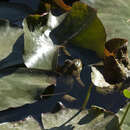Description
provided by AmphibiaWeb articles
With a maximum snout-vent length of 102 mm, it is a large member of the Rana boylii group. Its distinquishing characteristics include an inner but no outer metatarsal tubercle, dorsolateral folds usually absent but occasionally present and poorly developed, an indistinct usually tympanium, and no vocal sacs in males. In addition, R. tarahumarae is pustulose and has a brown dorsum with small black or brown spots on the body, with white crossbars on the fron and hind limbs. The ventral body surface is white, the throat and chest can sometimes by gray with an indefinite melanophore pattern, and yellow con be present in the groin area. The tips of the toes are just a little bit expanded, and the toes are broadly webbed to the tips. In males, the first digit is enlarged and has a nuptial pad, but they lack vocal sacs.
Zweifel, R. G. (1963). ''Rana tarahumarae (Boulenger). Tarahumara Frog.'' Catalogue of American Amphibians and Reptiles. American Society of Ichthyologists and Herpetologists, 66.1-66.2.
- author
- Franziska Sandmeier
Distribution and Habitat
provided by AmphibiaWeb articles
The range extends from the south-central edge of Arizona through the Sierra Madre Occidental of eastern Sonora to southwestern Chihuahua and nothern Sinaloa. The habitat of R. tarahumarae includes canyon streams, some of which may only hold water in small, isolated pools in the dry season. The species is associated with oak woodland, tropical deciduous forest and pine forest vegetation, and occurs only between 1500 and 6000 feet.
- author
- Franziska Sandmeier
Life History, Abundance, Activity, and Special Behaviors
provided by AmphibiaWeb articles
The larvae are at least 97 mm long, and have a greenish gray color, with prominent black spots on the tail fin and musculature. They have a labial fringe which is indented at the corners of the mouth and has a large gap in its anterior edge. They have a maximmum of five upper and three lower rows of labial teeth.
- author
- Franziska Sandmeier
Tarahumara frog: Brief Summary
provided by wikipedia EN
The Tarahumara frog (Lithobates tarahumarae) is a species of frog in the family Ranidae found in Mexico and—formerly—the United States, where it is now regionally extinct. Its natural habitats are streams and plunge pools in canyons in oak and pine-oak woodland, and foothill thorn scrub and tropical deciduous forest in the Pacific coast tropical area. Permanent water is necessary for reproduction.
The decline of Tarahumara frog populations has many reasons and may include chytridiomycosis and introduced species.
The Tarahumara are a well-known indigenous tribe from the Copper Canyon of northern Mexico.
- license
- cc-by-sa-3.0
- copyright
- Wikipedia authors and editors

